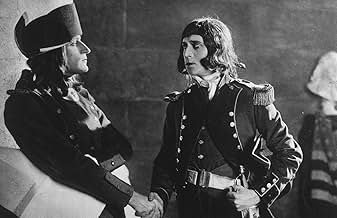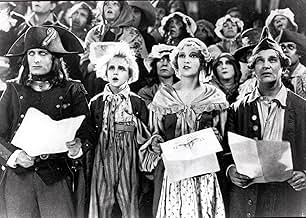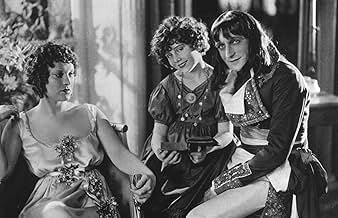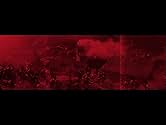IMDb-BEWERTUNG
8,2/10
9519
IHRE BEWERTUNG
Ein Film über die Jugend und die frühe Militärkarriere des französischen Generals.Ein Film über die Jugend und die frühe Militärkarriere des französischen Generals.Ein Film über die Jugend und die frühe Militärkarriere des französischen Generals.
- Auszeichnungen
- 4 wins total
Nicolas Roudenko
- Napoléon Bonaparte enfant
- (as Vladimir Roudenko)
Max Maxudian
- Barras
- (as Maxudian)
Empfohlene Bewertungen
10fiddybop
The (more or less) full length version of Gance's NAPOLEON assembled by Kevin Brownlow over many years is an absolutely astounding achievement, both for Gance's inspired execution of a vision nearly too big for the screen, and Brownlow's dedication and perseverance, not to mention his superb reconstruction skills in bringing such a masterpiece back for the enjoyment of the world.
Well, not the whole world... Despite all this effort, the full restoration cannot be seen in the United States, on video or theatrically. It's a long story, but I just wanted potential and past viewers of this film to be aware of a few things:
-First of all, though video may be the only way to see this film in the U.S., keep in mind that home video can not even come close to providing the proper setting for such a gorgeous and epic film. The word "epic" has in fact never been so appropriate. So while I don't discourage people from seeing the video for lack of theatrical viewing opportunities, remember that the film was made on and meant to be seen on a grand scale.
-Secondly, the version currently available in the U.S. is not shown at the correct speed (24fps instead of the necessary 18/20fps). Also, it is missing footage. It is my understanding that in order to provide wider release possibilities in the U.S. upon the completion of the first major restoration in the '70s, the U.S. prints were edited somewhat to cut down on the admittedly long running time. This is also why the film is shown faster in the U.S., at "sound speed" or 24 frames per second. The newest restoration runs at 333 minutes, while the U.S. version is only 235.
The primary reason why the latest, glorious 2000 restoration of the film cannot be seen in the U.S. lies mainly with Francis Ford Coppola. Coppola controls the U.S. distribution rights, and allows only the U.S. version - with a score written by his father - to be shown. This is unlikely to change in the near future, so until then, deal with the substandard videotapes or plan your next European trip around one of the periodic English screenings of the film version - believe me, it's worth it!!
Well, not the whole world... Despite all this effort, the full restoration cannot be seen in the United States, on video or theatrically. It's a long story, but I just wanted potential and past viewers of this film to be aware of a few things:
-First of all, though video may be the only way to see this film in the U.S., keep in mind that home video can not even come close to providing the proper setting for such a gorgeous and epic film. The word "epic" has in fact never been so appropriate. So while I don't discourage people from seeing the video for lack of theatrical viewing opportunities, remember that the film was made on and meant to be seen on a grand scale.
-Secondly, the version currently available in the U.S. is not shown at the correct speed (24fps instead of the necessary 18/20fps). Also, it is missing footage. It is my understanding that in order to provide wider release possibilities in the U.S. upon the completion of the first major restoration in the '70s, the U.S. prints were edited somewhat to cut down on the admittedly long running time. This is also why the film is shown faster in the U.S., at "sound speed" or 24 frames per second. The newest restoration runs at 333 minutes, while the U.S. version is only 235.
The primary reason why the latest, glorious 2000 restoration of the film cannot be seen in the U.S. lies mainly with Francis Ford Coppola. Coppola controls the U.S. distribution rights, and allows only the U.S. version - with a score written by his father - to be shown. This is unlikely to change in the near future, so until then, deal with the substandard videotapes or plan your next European trip around one of the periodic English screenings of the film version - believe me, it's worth it!!
I saw this back in '81 or '82, on the Big Screen at the Shrine Auditorium in Los Angeles, with Carmine Coppola conducting a live orchestra -- there has never been anything like that in all my movie-going experience! The closest that's come since was _Intolerance_, restored, with another live orchestra performing under the baton of the composer, Gillian Anderson (no, not the one from the X-Files). That, too, was an occasion to remember ... but where is Napoleon on DVD?
As many other reviewers have said, Napoleon was a relevatory experience. Certainly, other films to that point had used most of the devices Gance employed so brilliantly (except, of course, his three-screen-wide "Polyvision"), but then sound came in and the requirements of the microphone killed the recently mobilized camera. The camera became very static for at least the next ten years of films -- dynamic camera movements only returned when sound mixing came in to being, and scenes could be shot MOS (mit out sound), with foley and overdubbing replacing the missed sounds.
For this reason, Napoleon is important to see -- as a technical achievement. But Gance's artistry wasn't limited to gimmicks. His pacing, editing, and direction of the actors (including Dieudonne as Nappy -- looking amazingly Rod-Stewart-like) is excellent as well.
Highly recommended -- and when the DVD comes out -- hopefully, with the fuller, five-hour restoration, and Coppola's music on one track, with a reconstruction of the original music on another (and perhaps Gillian Anderson has a score of her own to share?) -- you'll owe it to yourself, as a student of Film, to see it, over and over again.
As many other reviewers have said, Napoleon was a relevatory experience. Certainly, other films to that point had used most of the devices Gance employed so brilliantly (except, of course, his three-screen-wide "Polyvision"), but then sound came in and the requirements of the microphone killed the recently mobilized camera. The camera became very static for at least the next ten years of films -- dynamic camera movements only returned when sound mixing came in to being, and scenes could be shot MOS (mit out sound), with foley and overdubbing replacing the missed sounds.
For this reason, Napoleon is important to see -- as a technical achievement. But Gance's artistry wasn't limited to gimmicks. His pacing, editing, and direction of the actors (including Dieudonne as Nappy -- looking amazingly Rod-Stewart-like) is excellent as well.
Highly recommended -- and when the DVD comes out -- hopefully, with the fuller, five-hour restoration, and Coppola's music on one track, with a reconstruction of the original music on another (and perhaps Gillian Anderson has a score of her own to share?) -- you'll owe it to yourself, as a student of Film, to see it, over and over again.
... and remarkable even in it's current, truncated form. The film details the early life of Napoleon Bonaparte (Albert Dieudonne), from his unpleasant childhood in boarding school to his early military life during the French Revolution and the subsequent Reign of Terror, through to his first military victories and marriage to Josephine (Gina Manes). Also featuring Annabella and Abel Gance as Saint-Just.
Gance seems to have taken note of every cinematic technique of the previous 30 years of the medium, combining them all into a breathtaking, exhaustive epic that transcends the time of it's making while being wholly of it, as well. This could not exist with such strength as anything but a silent film, I feel, as the reliance on visual stimulus forced Gance into finding new and exciting ways to express emotion and mood. His early use of montage editing and super-imposition of imagery is stellar. The use of handheld cameras adds to the immediacy of the revolutionary scenes, conveying a newsreel touch that seems far advanced from other films of its day. The sets and costumes are very impressive, as is the cast of thousands. Dieudonne resembles Olivier's Richard III more than any other screen Napoleon that I've seen, but it works, and I wonder if this is the image I'll conjure in the future when thinking of the French military genius.
This movie has a storied existence, with multiple running times and edits throughout the decades. Gance's original version is said to have run over 9 hours, but subsequent edits ran as short as 115 minutes (the 1929 US release). Noted British film historian and preservationist Kevin Brownlow has made it his life's work to try and restore the movie as closely as possible to Gance's original vision. The version that I watched was the recently released BFI version, supervised by Brownlow, and it ran 333 minutes, or about 5 and a half hours. It's definitely a must see.
Gance seems to have taken note of every cinematic technique of the previous 30 years of the medium, combining them all into a breathtaking, exhaustive epic that transcends the time of it's making while being wholly of it, as well. This could not exist with such strength as anything but a silent film, I feel, as the reliance on visual stimulus forced Gance into finding new and exciting ways to express emotion and mood. His early use of montage editing and super-imposition of imagery is stellar. The use of handheld cameras adds to the immediacy of the revolutionary scenes, conveying a newsreel touch that seems far advanced from other films of its day. The sets and costumes are very impressive, as is the cast of thousands. Dieudonne resembles Olivier's Richard III more than any other screen Napoleon that I've seen, but it works, and I wonder if this is the image I'll conjure in the future when thinking of the French military genius.
This movie has a storied existence, with multiple running times and edits throughout the decades. Gance's original version is said to have run over 9 hours, but subsequent edits ran as short as 115 minutes (the 1929 US release). Noted British film historian and preservationist Kevin Brownlow has made it his life's work to try and restore the movie as closely as possible to Gance's original vision. The version that I watched was the recently released BFI version, supervised by Brownlow, and it ran 333 minutes, or about 5 and a half hours. It's definitely a must see.
Four showings at the art deco palace Paramount Theatre in downtown Oakland on March 24, 25, 31 and April 1 will be a landmark for cinemaphiles. From the opening snowball fight to the closing triptych of the eagle's shadow leading the Grande Armee, there was so much to love. Abel Gance takes you on a journey that your mind gets to ride with distinct pleasures. Robespierre in the John Lennonesque sunglasses, the teaching of the Marsailles, the dinghy with an escaping Napoleon and the General Assembly simultaneously in stormy seas, are but a few. I can't imagine I'll ever watch this on DVD after seeing it like I did. I certainly could never consider a sped up 24pp version. I watched Metropolis once like that and it just wasn't the same film. In fact criminal. So weirdly, I recommend the film but can't recommend seeing it unless a better format is available. I'm going to buy Carl Davis' score and play the film in my head from memory, which includes the crowd at the Paramount rising to their feet at the close shouting Vive La France! Vive La Gance!
January 23, 1981. Radio City Music Hall. Nearly midnight. One of the most thrilling experiences of my life. "Napoleon", restored, and reconstructed, not seen for over fifty years, was debuting in front of 6,000 people packed into the great theater with Carmine Coppolla conducting a huge orchestra rising up on the lift as lighting cast fifty foot shadows of the conductor on the walls. The score was magnificent. By the end of the film when the tryptyches stretched the size of the screen to triple size filling the glorious famous sunburst proscenium, Radio City Music Hall erupted in a standing ovation - and Kevin Brownlow, who restored the film, at that very moment from the theater had Abel Gance (soon to die) live on the phone from France to hear the ovation! Just incredible. Glorious. The film is a masterpiece of the Twentieth Century. And a must see. The best scene was the battle in the Convention between the Girondists and Jacobins superimposed on Napoleon's escape from Corsica in a sea storm. Staggering editing and camera work. It is a tragedy for us all the the remaining chapters of Napoleon's life were never put on film as Gance planned.
Wusstest du schon
- WissenswertesAbel Gance remembered one scene that was removed by the censors--that of the execution of civilians by soldiers. The camera is used like a bullet, zooming towards one human target, then another, then another. The sequence is lost, although a still photograph does survive.
- PatzerOne of the Corsicans in the inn states "Our fatherland is Italy with the Duke of Savoy". The Duchy of Savoy had ceased to exist in 1713 (eighty years earlier), when the Duchy acquired the Kingdom of Sardinia and the Duke then bore the title of the King of Sardinia. Italy was a geographic place not a political entity at this time.
- Alternative VersionenThere are apparently at least 19 different versions of this film, starting with the original 6-hours cut (in a "triptych" format, requiring three projectors on three screens, called Polyvision). It has been shown in various formats and different running times, including a 1934 version re-edited by director Abel Gance and featuring an added soundtrack.
- VerbindungenEdited into Napoléon Bonaparte (1935)
- SoundtracksThe Thrill of Being In Love (Love Theme of Napoleon and Josephine)
Music by Carmine Coppola
Lyrics by Italia Coppola (USA version)
UK version: score by Carl Davis (based largely on works by Beethoven)
Top-Auswahl
Melde dich zum Bewerten an und greife auf die Watchlist für personalisierte Empfehlungen zu.
- How long is Napoleon?Powered by Alexa
Details
- Erscheinungsdatum
- Herkunftsland
- Sprache
- Auch bekannt als
- Abel Gance's Napoleon
- Drehorte
- Domaine des Milelli, Ajaccio, Corse-du-Sud, Frankreich(Paolists' attack on Bonapartes' country house)
- Produktionsfirmen
- Weitere beteiligte Unternehmen bei IMDbPro anzeigen
Box Office
- Budget
- 20.000.000 FRF (geschätzt)
- Weltweiter Bruttoertrag
- 39.448 $
- Laufzeit
- 4 Std.(240 min)
- Farbe
- Sound-Mix
- Seitenverhältnis
- 1.33 : 1
Zu dieser Seite beitragen
Bearbeitung vorschlagen oder fehlenden Inhalt hinzufügen









































